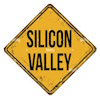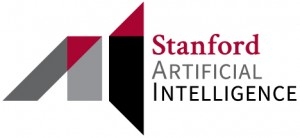 Silicon Valley
Silicon Valley
AI moves to the West Coast
Given the legacy of the Dartmouth Conference, New England could rightfully lay claim to the title "birthplace of AI", but Silicon Valley quickly took the mantle cross-country from the Atlantic Coast to the Pacific Coast. South of the City by the Bay lies Silicon Valley; a flat, basin-like region framed by coastal mountains to the West and the San Francisco Bay to the East. Also known as the Santa Clara Valley, in its former life it was a rich agricultural area renowned for growing prunes, apricots, cherries, peaches, pears, strawberries, and nectarines. The valley features warm days, cool nights, and well-drained soils. It is fed by the Guadalupe River and a number of artesian wells. And in its fruit orchard heydey it had the nearby Southern Pacific railroad to rapidly ship the abundant fruit crop nationwide. With the post-war westward migration to California, orchards were replaced over time by suburbs, offices, and highways.
In the midst of Silicon Valley lies one of the greatest institutions of higher learning in the world, Stanford University. Stanford was the catalyst that transformed the Santa Clara Valley from farmland into the world's tech capital. It has been ground zero for AI research since the field's inception, producing innovations, companies, and leaders who shaped Silicon Valley.
Stanford has been the cradle of AI innovation since the beginning. Its unique blend of academia, entrepreneurship, and Silicon Valley synergy ensures it remains at the forefront.
![]()
Here's a list of famous Stanford tech alumni who founded or led major companies, with their graduation years and key contributions:
Founders of Tech Giants
-
Larry Page (MS '95) and Sergey Brin (MS '95) - Co-founded Google (1998).
-
Elon Musk (Dropped out, PhD '95-97) - Founded Tesla, SpaceX, Neuralink.
-
Peter Thiel (BA '89, JD '92) - Co-founded PayPal, first investor in Facebook.
-
Reid Hoffman (MA '90) - Co-founded LinkedIn.
-
Jerry Yang (MS '90) - Co-founded Yahoo!
-
Mike Krieger (BS '04) and Kevin Systrom (BS '06) - Co-founded Instagram.
-
Evan Spiegel (Dropped out '13) - Co-founded Snapchat.
Semiconductor and Computing Pioneers
-
William Hewlett (BS '34, MS '36) and David Packard (MS '39) - Founded HP.
-
Gordon Moore (PhD '54) - Co-founded Intel, formulated Moore's Law.
-
Vinod Khosla (MS '80) - Co-founded Sun Microsystems, now VC at Khosla Ventures.
-
Jensen Huang (MS '92) - Co-founded NVIDIA.
AI and Software Leaders
-
Fei-Fei Li (PhD '05) - AI pioneer, created ImageNet, co-director of Stanford HAI.
-
Andrew Ng (PhD '02) - Founded Google Brain, Coursera, led AI at Baidu.
-
Marissa Mayer (MS '97) - Early Google employee, later CEO of Yahoo!
Venture Capital and Investors
-
Don Valentine (BS '52) - Founder of Sequoia Capital (backed Apple, Cisco).
-
Marc Andreessen (Did not graduate) - Co-founded Netscape, Andreessen Horowitz.
-
Mary Meeker (MBA '86) - "Queen of the Internet," VC at Bond Capital.
Aerospace and Futurists
-
Sally Ride (PhD '78) - First American woman in space (NASA astronaut).
-
Sebastian Thrun (Former professor) - Founded Google X, Udacity, Kitty Hawk.
Recent Unicorn Founders
-
Patrick Collison (Dropped out '09) - Co-founded Stripe.
-
Alex Karp (PhD '92) - CEO of Palantir.
-
Anne Wojcicki (BS '96) - Co-founded 23andMe.
One name that's not on the list is John McCarthy. That's because McCarthy was not a Stanford student--he received his Ph.D. at Princeton--but joined Stanford University in 1962 as an Assistant Professor, leaving MIT where he developed LISP, and subsequently transformed Stanford into a global epicenter of AI research.

Ever the organizer, McCarthy founded the Stanford AI Lab (SAIL) in 1963. SAIL occupied the former Stanford Department of Electrical Engineering's D.C. Power Lab, a quirky building in the foothills above the campus. The AI Lab had a unique culture that fostered a creative environment where researchers were able to work all hours. The Lab had "beer bashes" every Friday afternoon to encourage collaboration, teamwork, and have a little fun after a long work week. Decor included a Jimi Hendrix poster and a disassembled car engine. SAIL maintained a "hands-off" management style that empowered young researchers. It was primarily supported by DARPA (Defense Advanced Research Projects Agency), with McCarthy securing the initial $500,000 grant, reminiscent of his prior work securing funding from the Rockefeller Foundation for the Dartmouth Conference.
McCarthy's 1960s work at Stanford didn't just create a research lab; it established an entire paradigm for how artificial intelligence would be studied and developed for generations. The questions he posed and approaches he developed continue to shape AI research, making the decade of the 60s one of the most productive and influential periods in the history of computer science.
 We'd love your thoughts on the book ❤️
We'd love your thoughts on the book ❤️
 Links
Links
AI in America home page
Biographies of AI pioneers